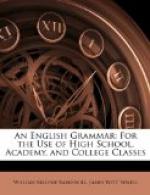31. When the older _-en_ and _-ster_ went out of use as the distinctive mark of the feminine, the ending _-ess_, from the French _-esse_, sprang into a popularity much greater than at present.
[Sidenote: Ending -ess less used now than formerly.]
Instead of saying doctress, fosteress, wagoness, as was said in the sixteenth century, or servauntesse, teacheresse, neighboresse, frendesse, as in the fourteenth century, we have dispensed with the ending in many cases, and either use a prefix word or leave the masculine to do work for the feminine also.
Thus, we say doctor (masculine and feminine) or woman doctor, teacher or lady teacher, neighbor (masculine and feminine), etc. We frequently use such words as author, editor, chairman, to represent persons of either sex.
NOTE.—There is perhaps this distinction observed: when we speak of a female as an active agent merely, we use the masculine termination, as, “George Eliot is the author of ‘Adam Bede;’” but when we speak purposely to denote a distinction from a male, we use the feminine, as, “George Eliot is an eminent authoress.”
III. Gender shown by Different Words.
32. In some of these pairs, the feminine and the masculine are entirely different words; others have in their origin the same root. Some of them have an interesting history, and will be noted below:—
bachelor—maid boy—girl brother—sister drake—duck earl—countess father—mother gander—goose hart—roe horse—mare husband—wife king—queen lord—lady wizard—witch nephew—niece ram—ewe sir—madam son—daughter uncle—aunt bull—cow boar—sow
Girl originally meant a child of either sex, and was used for male or female until about the fifteenth century.
Drake is peculiar in that it is formed from a corresponding feminine which is no longer used. It is not connected historically with our word duck, but is derived from ened (duck) and an obsolete suffix rake (king). Three letters of ened have fallen away, leaving our word drake.
Gander and goose were originally from the same root word. Goose has various cognate forms in the languages akin to English (German Gans, Icelandic gas, Danish gaas, etc.). The masculine was formed by adding _-a_, the old sign of the masculine. This gansa was modified into gan-ra, gand-ra, finally gander; the d being inserted to make pronunciation easy, as in many other words.
Mare, in Old English mere, had the masculine mearh (horse), but this has long been obsolete.
Husband and wife are not connected in origin. Husband is a Scandinavian word (Anglo-Saxon husbonda from Icelandic hus-bondi, probably meaning house dweller); wife was used in Old and Middle English to mean woman in general.




